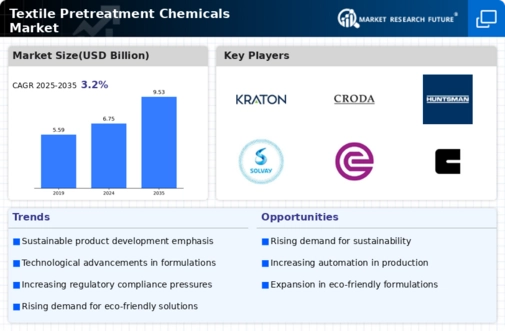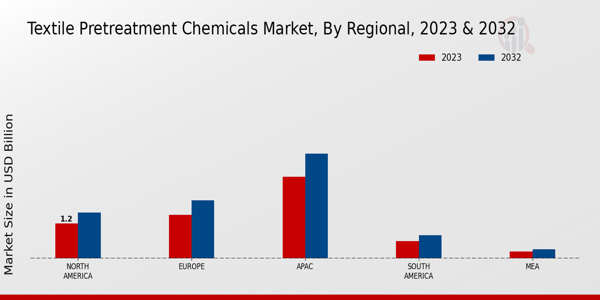Market Trends and Growth Projections
The Global Textile Pretreatment Chemicals Market Industry is characterized by various trends that indicate its growth trajectory. The market is projected to reach 6.75 USD Billion in 2024, with a steady increase expected over the next decade. Factors such as the rising demand for sustainable textiles, technological advancements, and the growth of the fashion sector contribute to this positive outlook. Additionally, the anticipated compound annual growth rate of 3.18% from 2025 to 2035 suggests a robust market environment. These trends highlight the dynamic nature of the industry, as stakeholders adapt to evolving consumer preferences and regulatory landscapes.
Emerging Markets and Global Expansion
Emerging markets present significant opportunities for the Global Textile Pretreatment Chemicals Market Industry. As economies develop, there is a growing demand for textiles, leading to increased production capacities. Countries in Asia-Pacific and Latin America are witnessing rapid industrialization, which drives the need for efficient pretreatment processes. This expansion is likely to be supported by investments in infrastructure and technology, facilitating the growth of the pretreatment chemicals market. The anticipated compound annual growth rate of 3.18% from 2025 to 2035 underscores the potential for market expansion in these regions, as manufacturers seek to capitalize on new opportunities.
Rising Demand for Sustainable Textiles
The Global Textile Pretreatment Chemicals Market Industry is witnessing an increasing demand for sustainable textiles, driven by consumer preferences for eco-friendly products. As manufacturers strive to meet these expectations, they are adopting pretreatment chemicals that minimize environmental impact. This shift is evident in the growing use of biodegradable and non-toxic chemicals, which align with sustainability goals. The market is projected to reach 6.75 USD Billion in 2024, reflecting this trend. Furthermore, the emphasis on sustainability is likely to influence the development of innovative pretreatment solutions, enhancing the overall market landscape.
Growth of the Fashion and Apparel Sector
The Global Textile Pretreatment Chemicals Market Industry is significantly influenced by the growth of the fashion and apparel sector. As the industry expands, the demand for high-quality textiles increases, necessitating effective pretreatment processes. The fashion sector's focus on rapid production cycles and diverse fabric types drives the need for specialized pretreatment chemicals. This trend is expected to contribute to the market's growth, with projections indicating an increase to 9.53 USD Billion by 2035. The interplay between fashion trends and pretreatment chemical innovations is likely to shape the future landscape of the market.
Regulatory Compliance and Safety Standards
Regulatory compliance and safety standards are critical drivers in the Global Textile Pretreatment Chemicals Market Industry. Governments worldwide are implementing stringent regulations to ensure the safety of chemicals used in textile processing. Compliance with these regulations necessitates the adoption of safer and more environmentally friendly pretreatment chemicals. Manufacturers are increasingly investing in research and development to create formulations that meet these standards while maintaining performance. This focus on compliance not only enhances product safety but also fosters consumer trust, ultimately contributing to the market's growth as companies seek to align with regulatory expectations.
Technological Advancements in Textile Processing
Technological advancements play a pivotal role in shaping the Global Textile Pretreatment Chemicals Market Industry. Innovations in chemical formulations and processing techniques enhance the efficiency and effectiveness of pretreatment processes. For instance, the introduction of advanced enzymatic treatments has improved the removal of impurities while reducing water and energy consumption. These advancements not only optimize production but also contribute to cost savings for manufacturers. As the industry evolves, the integration of smart technologies and automation is expected to further streamline operations, thereby driving market growth and expanding the range of available pretreatment chemicals.























Leave a Comment